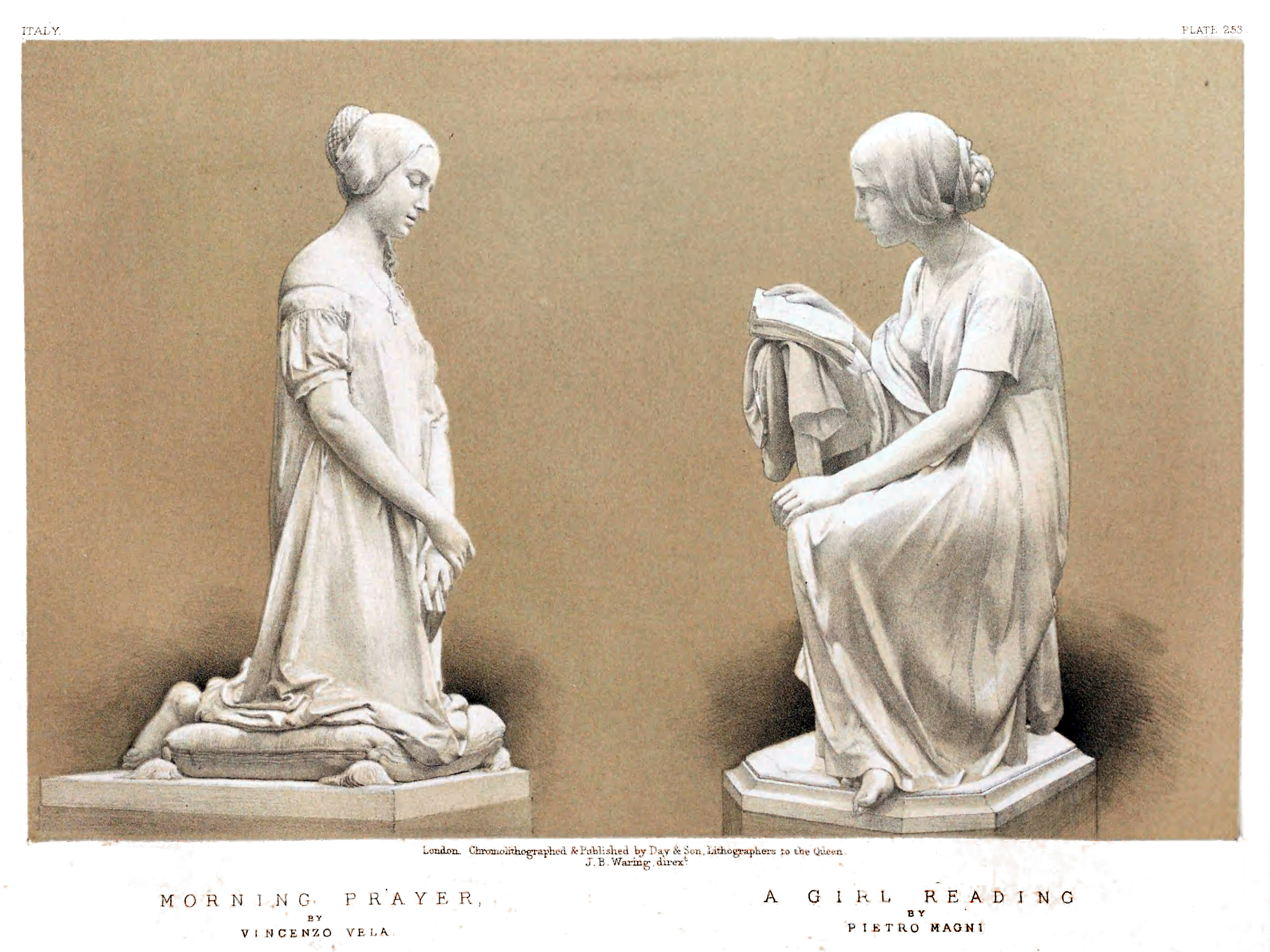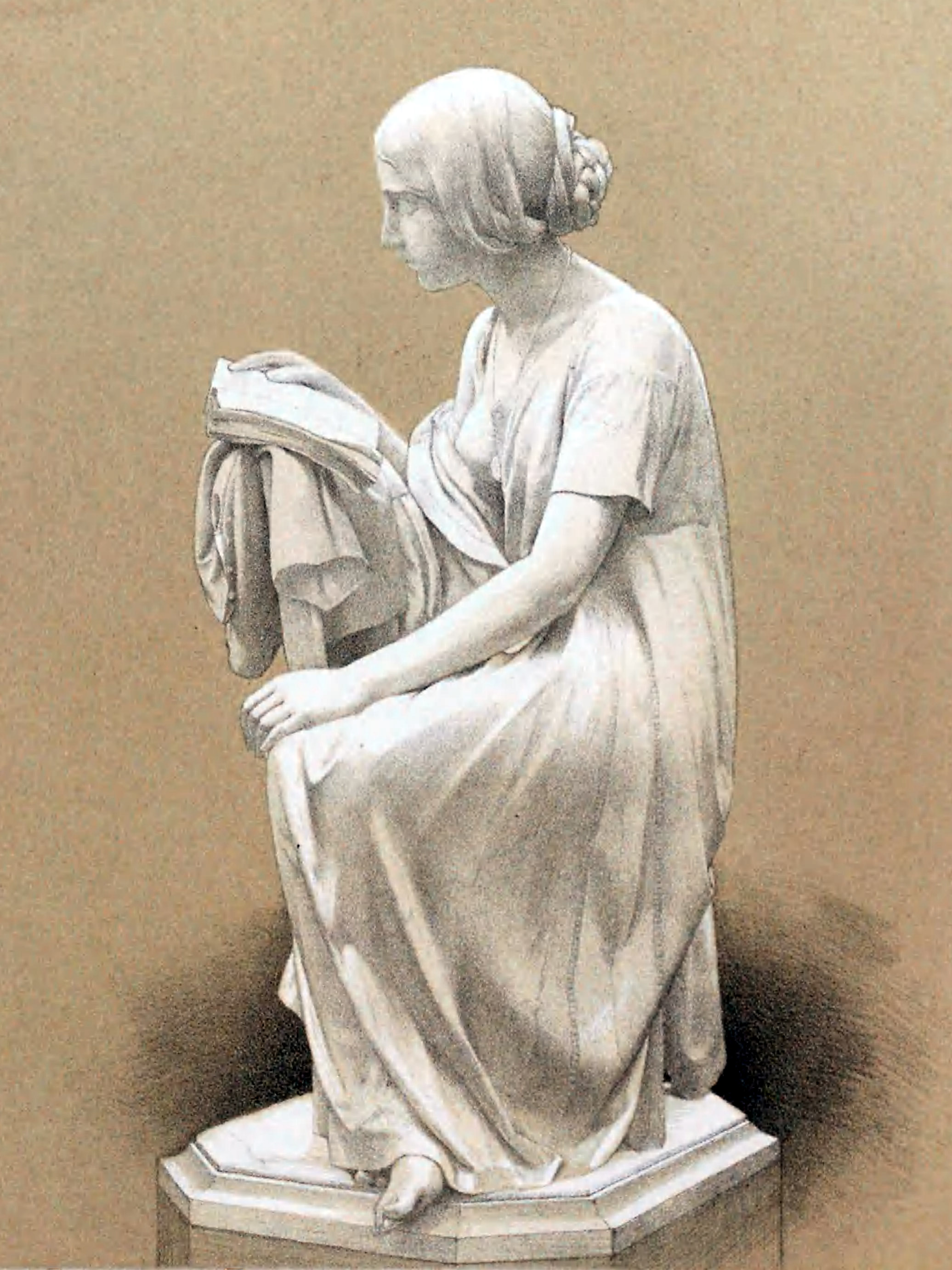Masterpieces of Industrial Art & Sculpture at the International Exhibition, 1862
by John Burley Waring, 1863.
Marble Statues
“PRAYER”,
BY V. VELA;
“A GIRL READING,”
BY P. MAGNI, ITALY.
 PLATE 253.
PLATE 253. THE marble statue, “Morning Prayer,” a charming production of the Torinese sculptor Professor Vidcenzo Vela, was contributed to the Exhibition by the Count Giulio Litta. The statue of “A Girl Reading,” by the eminent sculptor Pietro Magni, of Milan, has now become so well known, through the number of notices already published concerning it, and the crowds by which it was always surrounded, as to need but slight description. A replica of this statue was purchased by the London Stereoscopic Company. Both these statues, of life-size, are good examples of the realistic school, the latter piece especially being one of striking merit; it represents a young girl, seated in a natural, easy pose, who, partially undressed, prior to retiring to her bed, has taken up the heroic poem of Niccolini. What words are they that keep her thus motionless and enrapt, with drawn breath, her lips slightly parted, her eyes intensely fixed upon the page? Peer over her shoulder, and you will then understand why this maiden, who wears round her neck a medal impressed with the head of Garibaldi, is thus absorbed these are the words she reads:
“Mi projeta Iddio! veggo concordi
Fede gillrarsi i popoli Lombardi,
E di venti cittadi al ciel s' inalza
Tra le ceneri e il sangue, un sol vessillo.
Tra le stragi de' suoi, veggo i Tedeschi
Oltr' Alpe fuggir, tratta nel fango
L’ Aquila ingorda, e un popolo redento
Farsi luilibrio della lor corona.”
Such ardent and patriotic thoughts, prophetic in their inspiration, stir the young Italian maiden's heart, and her earnest look of attention is wonderfully rendered by the artist.
Pietro Magni was born of poor parents at Milan in the year 1817. At the age of thirteen he was apprenticed to a mercer; but finding it impossible to control his strong natural bent for art, he subsequently obtained an entrance into the atelier of the sculptor Guelfi to learn the rudiments of his art, and was admitted as student in the Milan Academy of Fine Arts, where he carried away several prizes. Having completed his studies, he became assistant to several sculptors, such as Benzoni, Motelli, Manfredini, and Sangiorgio. He still found time to model some of his own ideas, and in the year 1844 produced “The Offering of a Flower,” which was generally admired, though in that natural style which Magni has since rendered so well, and which was quite opposed to the classic principles of his former masters. In 1848 he entered with spirit into the national movement; helped to chase the Austrians out of Milan; distinguished himself at the great battle of Novara, in the brave corps of Manara, whom he followed to Rome, and took part ill its defence against the French. On the fall of that city he returned to his old studies, and executed an equestrian statuette of his old commander, Manara, which speedily became very popular. He now returned to Milan, and produced Ills groups in marble of “The First Steps,” exhibited at the Brera, Milan, in 1850, which, besides its natural charms, representing an Italian mother guiding the first steps-of her infant, had a political significance which was fully appreciated. In 1851 this group was exhibited at the Great Exhibition in London, and was so much admired as to lead to several commissions being given to the patriotic sculptor. In the same year, the Academy of Milan having offered a prize for the best rendering of the subject “David slaying of Goliah,” Magni competed and carried off the prize. About the same time he modelled the “Angelica,” which was at the Paris Exhibition of 1855, and the “Masquer at her Toilet.” Shortly afterwards he produced his noble statue of “Socrates at the Theatre,” which proved him capable of producing works in the highest class of art, and which was followed by another fine classical statue of “Brutus haranguing the Romans after the Death of Cresar.” In 1856 the model of the “Girl Reading” was exhibited at Milan, and the marble statue at the Florence International Exhibition, 1861, when it was purchased by the ItaliaIi Government.
We have not space to enumerate the numerous works which, after all his trials, Magni was commissioned to execute between the years 1856 and 1862; one of the most important is a monument to Leonardo da Vinci, for the Italian Government, to be erected at Milan. Besides being decorated by his government with the medal for the defence of Rome, Magni has been made a Chevalier of the order San Maurizio and Lazzaro, and appointed professor of sculpture in the Academy of Fine Arts, Milan. Vela is the sculptor of the life-size group of “France and Italy,” lately presented by the ladies of Milan to the Empress of the French.

Marble Statues, Masterpieces of Industrial Art & Sculpture at the International Exhibition, 1862 by John Burley Waring, 1863.(PDF)